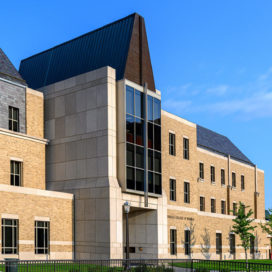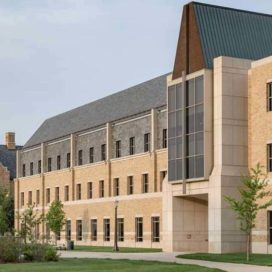Project’s foes vow to fight
Published: February 1, 2005 / Author: Jeff Writer
Developers say change in area is inevitable
BATTLE FOR A TOWNSHIP’S FUTURE
Ann Jentz, a self-described Libertarian who says she’s more conservative than Rush Limbaugh, finds herself in an odd situation these days.
She is desperate for government action.
Jentz is imploring city, county and state officials to kill developer Holladay Properties’ plans for a 600-acre multiuse development at Adams Road and the St. Joseph Valley Parkway. The project calls for “light industrial” buildings directly across the street from her Mayflower Road home of 21 years.
She can’t think of a land use more incompatible with her 12-acre spread, which features a regulation-size riding arena for the world champion appaloosa horses she breeds. She fears an industrial park so close by will erode her home’s value should she ever want to sell.
But Jentz says opponents, especially those along Mayflower Road, are not “radical lunatics” averse to land development of any kind. She would not mind if the empty fields became a residential subdivision, as has happened throughout the township over the past decade.
“Never once was I naive enough to think that field would stay undeveloped, but never in my freaking wildest dreams did I ever think it would be an industrial park,” she said. “I’m disgusted.”
She figured the city would someday annex her land, paving the way for her to subdivide and sell it.
“This is my retirement,” said Jentz, a 47-year-old lab technologist at LaPorte Hospital. “I’ve saved money and tried to hold on to this property with both hands since getting divorced six years ago. I don’t make a lot of money.”
Holladay, along with city officials who are eager to annex the site, say they can understand township residents wanting to maintain the area’s rural feel. But they say people must accept the inevitable.
The city and county’s Comprehensive Plan, adopted by the area plan commission in 2002, designates the site as an “industrial growth reserve” area, largely because of its proximity to the parkway, which connects with the Indiana Toll Road about a mile and a half to the south, noted Sharon Kendall, executive director of South Bend’s economic and community development department.
“They shouldn’t be surprised this would come,” Kendall said.
Kendall added she is confident that the developer will come up with satisfactory ways to buffer the project from the adjacent homes through the use of trees, berms, set-back space or some combination of the three. Those buildings that could still be seen would look nicer than typical industrial buildings, she added.
Responding to residents’ complaints about the potential for too much truck traffic on Mayflower, Holladay also has pledged to exit all traffic from the light industrial area to the south, through the existing city-owned U.S. 31 Industrial Park northeast of the parkway and Brick Road.
‘Things do change’
At a recent standing-room-only meeting, the second of two so far, German Township residents peppered Holladay executives with biting questions and bitter criticism. Holladay officials didn’t appear to win any more converts than in the initial meeting a month earlier.
“It’s not pleasant being in the path of growth, whether it’s us or someone else who brings it to you,” Holladay’s Doug Hunt told the crowd.
Frank Perri, Holladay’s senior vice president for development, didn’t tell the residents that he would voice the same objections if he was in their shoes — but he came close.
“I appreciate you want the country way of life,” Perri said. “I’m not here to persuade you. People around Grape Road liked their country life, too. Things do change and they do affect people. I understand.”
Those remarks provided little comfort to Jentz’ next-door neighbor, Rich Sheehan.
“It’s zoned residential,” Sheehan, a University of Notre Dame finance professor and former South Bend Community School Corp. trustee, said at the meeting. “You’re saying, ‘We’re going to change the ground rules.’ So you and the Waggoners end up gaining a lot of money by changing the ground rules, and we lose money.”
He was referring to the heirs of the late Chet Waggoner, who have agreed to sell Holladay 400 acres provided the developer gets the zoning and annexation it seeks.
Like Jentz, Sheehan has agreed to serve on a committee aimed at stopping the project. Sheehan is searching for a lawyer, who would be paid by residents’ pooled contributions, although he hopes the fight won’t proceed far enough to need one.
Sheehan thinks both the rezoning and annexation are on shaky legal footing. He believes the zoning change would amount to “spot zoning,” which violates the premise that zoning for adjacent pieces of land must be compatible. He compared the project to putting a Burger King restaurant in the middle of a residential subdivision.
Sheehan also charges that the developer’s plan to split the annexation into two parts, in order to comply with a state law requiring at least one-eighth of a targeted area to share a border with the annexing city, violates the “spirit” of the law because Holladay has publicly stated its desire to have the entire site annexed.
Much less than one-eighth of the entire site now touches city limits.
‘There’s roots here’
It remains to be seen whether a judge would halt the project on those grounds. Hunt said he is not worried.
“To me the spirit of the law is the letter of the law,” said Hunt, who was a widely respected state senator from 1976-96. “If we have to go through a two-stage process, what can we do about it? If that’s their strongest argument, I think we’ll be OK.”
Jentz and Sheehan do not lack confidence, either.
“It’s generally not good to bet against me,” Sheehan said. “We’re not sitting on four aces, but I also know the city doesn’t have four aces either.”
Jentz says she might have her own ace in the hole. The Mitchell’s satyr, a little butterfly whose endangered species status delayed the parkway extension near Berrien Springs, lives on her property, she claims. She had planned to keep quiet about the creature, for fear it could jeopardize her own ability to subdivide the land someday, but not anymore.
“I’m fixing to call the Environmental Protection Agency and drop the bomb,” she said. “I’ll fall on my sword.”
The developers don’t have any more support from neighbors on the site’s opposite side, where Bob Ehninger, 79, is the fourth generation of his family to farm his land. His son, Randall, and grandson, Brett, are following suit. Bob, along with his mother and grandmother, were born and raised in the 1873 home where Randall and his family now live.
Their Orange Road homestead, immediately north and northwest of the Waggoner land, would sit adjacent to new multi-family townhouses under Holladay’s current plans.
“There’s roots here,” the senior Ehninger said. “I don’t know what Holladay is thinking. I want to see John’s beef cattle (next door). I don’t want to see houses butting right up against our fence.”
But that tone of inevitability, the one Holladay would like opponents to accept, could be heard in the voice of Bob Ehninger’s wife, Lois.
“We want things to stay the same,” she said, “but they’re not going to, not with that place selling next to us.”
/news_and_events/news_articles/article/3772/project-s-foes-vow-to-fight




